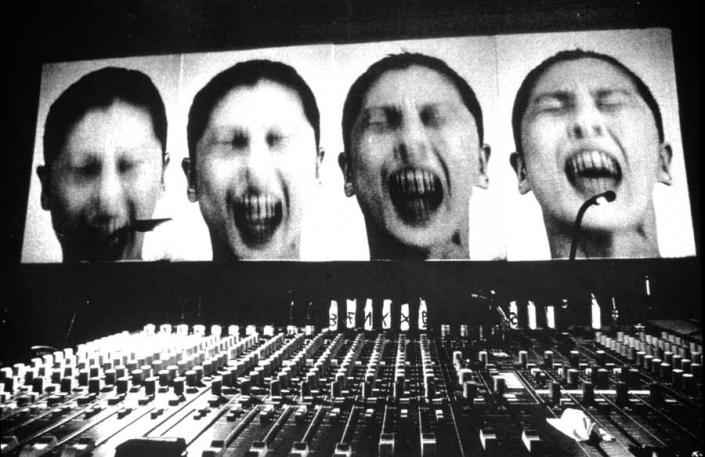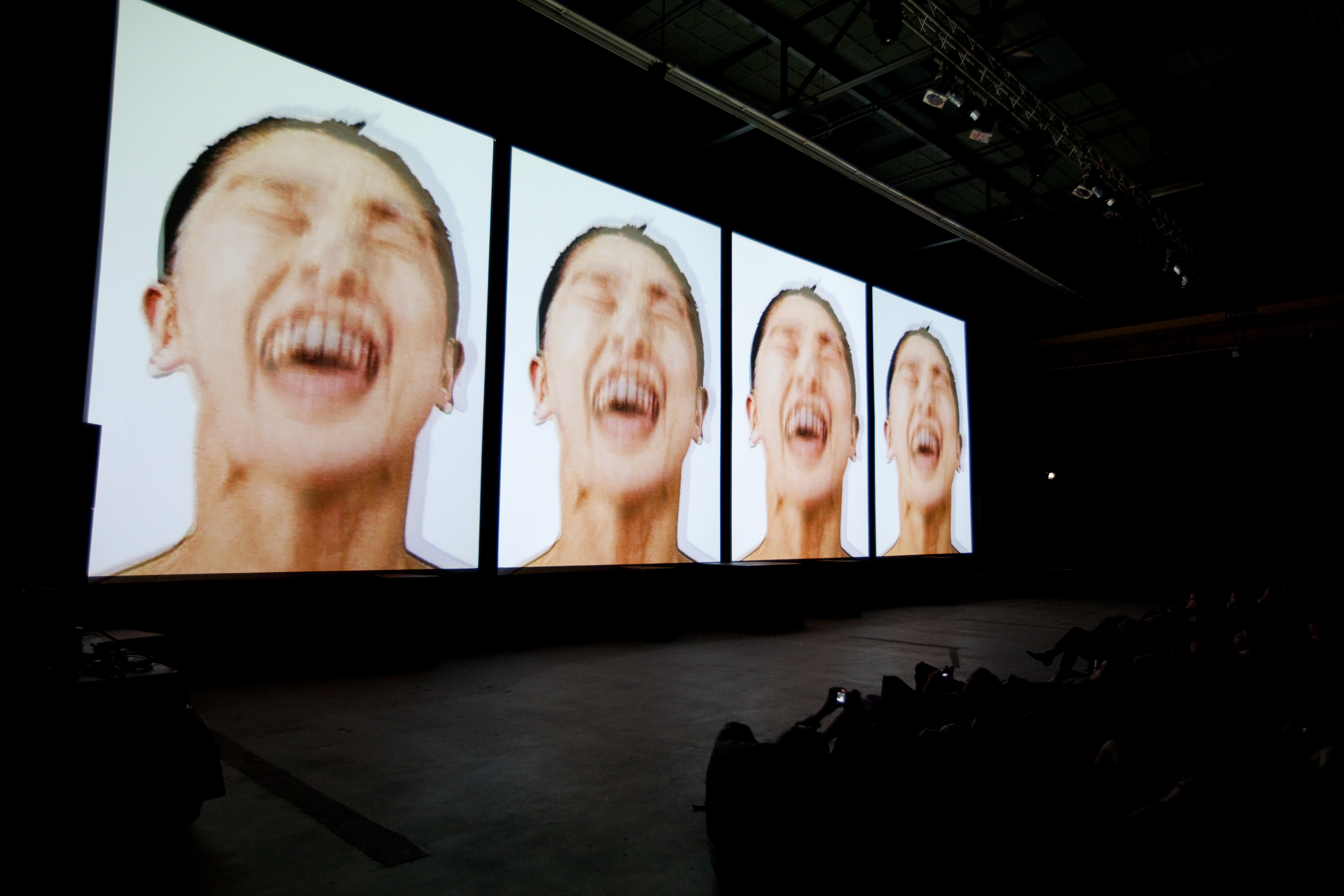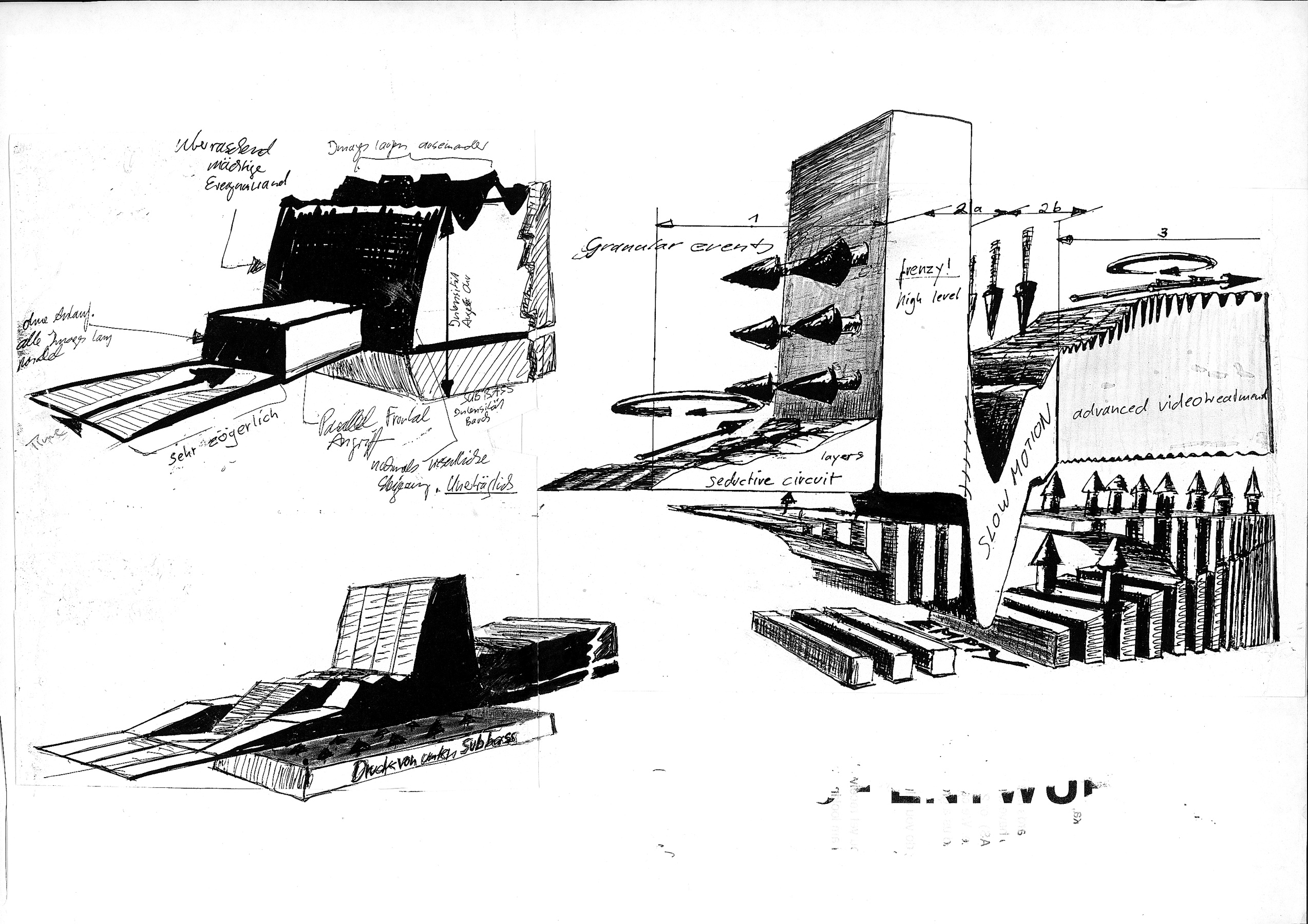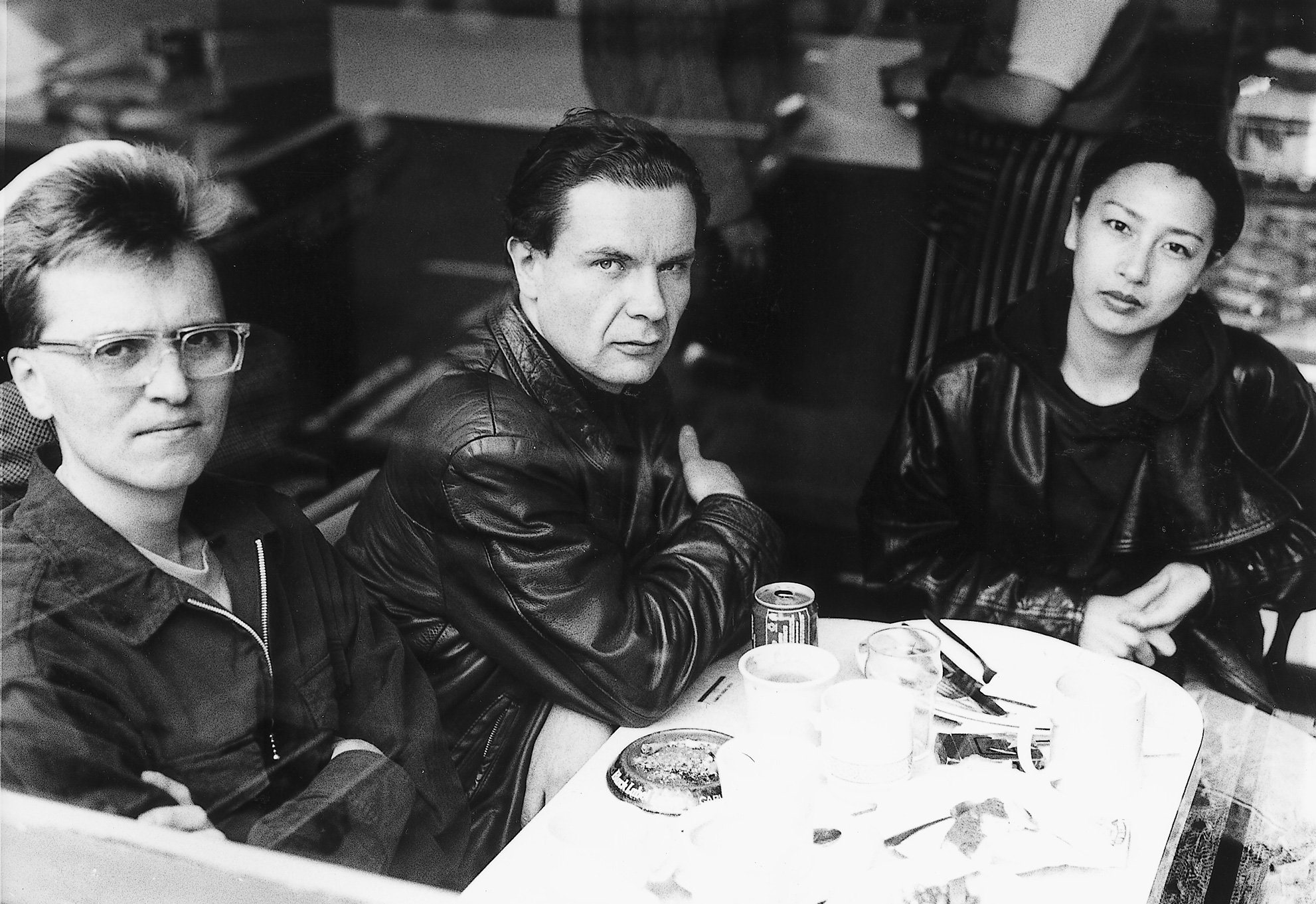Motion Control MODELL 5
(aka MODEL 5)
1994-1996
Audiovisual Performance and Installation
4-Channel Portrait Video, 12-Channel Audio
Featuring Performer Akemi Takeya









MODELL 5
MODELL 5, premiered 1994 at the ICC London, has been described as one of the most exhilerating experiments in bringing digital video to a theatrical setting. Using a technique derived from the principals of the sound design technique called “granular synthesis” but applied to the rather large grains of single video frames (visual content and sound), GRANULAR~ SYNTHESIS manages to evoke from a few expressions on the face of the performer Akemi Takeya, a frenzied exploration of the alter ego within touching distance
Motion Control
Shared Pain: Man and Machine
---------------------------------
Birgit Flos
MOTION CONTROL MODELL 5 by GRANULAR SYNTHESIS at the Kunstverein
A media event of the extreme kind lay ahead: Granular Synthesis' Modell 5 (co-produced by HULL TIME BASED ART, England, which premièred at the London ICA, with further performances in Ljubljana, Vienna, and at the Ars Electronica festival in Linz in June 1995). It is hard to describe what awaited the audience at the Kunstverein in terms of concentrated performances. One thing is sure: Granular Synthesis events are among the most consistent, intense and sensual experiences presently offered in "media art". The two artists Kurt Hentschläger and Ulf Langheinrich seem to be the people least interested in the spectacular attributes describing their work. Any account of extreme acoustic and visual experiences will drift towards the anecdotal all too fast. What is at stake here is not a presentation of top achievements in new technology praising the glossy aspects of media surfaces or liminal acoustic experiences but research on our time and its representation in the media (which is no less than a matter of life and death). By manipulating (video) images and sound (video sampling and audio loop techniques) a new visual and acoustic structure is built - different qualities, a new affective space is created - machine-generated aesthetics and sensuality.
Granular Synthesis: a name derived from the word "grain", "granum" in Latin, a term from electro-acoustics - the smallest possible particles (in this case image/sound segments from the video material) are taken out of the causal and temporal sequence in single frames, processed as independent portions and re-combined in a rather manipulated, artificial temporal sequence. MODELL 5.6, the title of the performance at the Kunstverein, indicates that this is one piece out of an open-ended series of experimental set-ups. For example, Modell 5.2 was shown at the 4th International Biennial of Nagoya, Japan (ARTEC) and awarded the Grand Prix for the best work in the open competition - hence, we are dealing with a work in progress.
Hentschläger and Langheinrich have worked on this research series since 1992: MotionControl - the subtitle of Modell 5 - sounds comparatively harmless as a program, yet again it is threatening, in a way: controlling motion, manipulating material, machine, time experience, pulse frequency. At the Kunstverein, the video analyses of the head of Akemi Takeya, a Japanese performer, were projected directly onto the white walls (the dimensions were 4 x 3 m each). The head made minute asynchronous moves: eyes looking sideways so slowly as if the movement would never end, a horizontal flicker, an almost imperceptible movement of the neck, with closed eyes and half-open mouth. The face was shoved up and down in such forceful and jerky motion that the flesh seemed torn from the bone, almost revealing the skeleton structure: gums, palate. Her head fluttered, bounced, twitched, vibrated, breathed, hesitated etc. At the same time, Hentschläger/Langheinrich acted as operators on site, serving the final mix of image and sound on-line. All interventions in the original material are time-based. Sound and image are not separated, not even in the smallest of segments. This process causes interesting technical/conceptual problems: the density of events in sound processing is much higher than in image processing (the definition on the sound level is higher than that the video definition) The digital and analog machines have to treat the image and sound analysis differently.
"Sound is what accounts for the highest degree of nervousness." At up to 200 beats per second and 6,000 watts it oscillates between collapse and transparency. No special effects are used to create the images. The material is treated violently: time lapse, slow motion, real time video scratching, enlargement, amplification, dissolution. The head moves like no head ever moves but still each individual segment is "true" in media terms. Material and machines are pushed to the limits. An imagery that is fully immanent in machines is generated while the aesthetics of machines is called into question at the same time. Absurd combinations of numbers are required from the machines, "errors" are provoked, software and hardware have to give their all. The artists aim at producing a "state of mind", at staging an extremely charged affective space. Out of the logic and absurdity of the machines, something is created which eventually pinpoints a spiritual quality hard to describe in the drone and noise of the images and sounds, in "leveling out" (U. Langheinrich). Potential strands of an action are broken off and lost before they can make sense in a narrative, monotonous shifts (or shifts of monotonies) into complex acoustic and visual interference "bespeak" the power and powerlessness of the machines and bodies, and the power and powerlessness of the operators who manipulate the machines and bodies. They reach a psychological-emotional state: arriving on wrong tracks, through disappointment, refusal, pain. The head, eyes, mouth, everything seems emotionally accessible, legible while they dissolve in their sensuality at the same time. The only thing that remains are drone and white noise. Level surface and line. In Kubrick's "2001 - A Space Odyssey", Hal the Computer sings a children's song before it dies, and it is the only being in the movie that dies a sentimental death, a machine afraid of death. Kubrick's movie comes up when the artists talk about MODELL 5: its alleged inconsistency - sub-stories are offered but not developed any further, films within the film emerge but none is completed. The performer's head serves as the primal image, the fixed point, delicate, fragile and beautiful. It all starts with seduction. The human head as an affirmative element invested with meaning in Western art - the portrait inevitably promises a "human" story, familiar connotations are activated. However, any known context of meaning ends in the dissolved movements, is stalled in denaturalized redundancy, in machine pain. The semantic void is too loud to be amenable to meditative reception. MODELL 5 is accurately defined in terms of duration (44 minutes) but different whenever it is performed though the basic structure remains the same. The frontal images, the rhythmic structures generate contradictory emotions and great strain. Entertainment is offered and almost violently denied. At the highest level of energy, enjoyment reaches the limit.
Kurt Hentschläger, born in Linz in 1960; Ulf Langheinrich, born in Wolfen, Anhalt-Saxony, in 1960,. They live in Vienna. Both are co-founders of the artists' group "Pyramedia". An abridged version of this article appeared in the daily "Der Standard" on March 17, 1995 when MODELL 5 was shown at the Vienna MAK.
----------------------------
The piece Motion Control MODELL 5 by the group "GRANULAR SYNTHESIS " is a direct descendant of video art with a penchant towards techno dance and rave parties. The group, composed of two Austrian artists, has taken over the stage in one of the La Victorine movie studios for the purpose and the duration of one concert. The concept of this "multi-media monument", as the work is described by its authors, consists in a video projection on four giant screens showing, in close-up, the head of Japanese model Akemi Takeya with a soundtrack played on several synthesizers broadcast over an extremely powerful PA system in surround. Practically motionless at first, the face of the model, eyes closed in desperation, gradually starts making jerky moves.
The movements, almost imperceptible in the beginning, are underscored by music which is basically composed of sound samples over a continuous bass line enveloping them; the bass is nearly palpable as it fills the studio. The sequences accelerate as the piece advances until they go into a frenetic, captivating trance. Extremely high-pitched rifts accentuate the piece, accompanying sudden deformations in the model's face which are broken down electronically in rapid succession.
There is no doubt that the expression "tremendous presence on the screen" has never been more to the point. Is that the hidden face of multi-media?
-Denis Fortier
-----------------------------
“It all starts with seduction. The human head as an affirmative element invested with meaning in Western art - the portrait inevitably promises a "human" story, familiar connotations are activated. However, any known context of meaning ends in the dissolved movements, is stalled in denaturalized redundancy, in machine pain. The semantic void is too loud to be amenable to meditative reception. The frontal images, the rhythmic structures generate contradictory emotions and great strain. Entertainment is offered and almost violently denied. At the highest level of energy, enjoyment reaches the limit.”
Birgit Flos, DER STANDARD
------------------------------
Every prejudice against Techno-Culture certainly has its justification - except in this case. Never before has more frenetic applause followed, without a doubt deserved by one the most intensive and, at the same time, open and free theatre evenings I have ever visited.
(Tagesspiegel/ Arnd Weseman about ISEA 95)
-------------------------------
The artistic treatment of alienation has not been experienced at its more frighteningly beautiful for a long, long time. (Kurier)
--------------------------------
The performance of the GRANSYN, which unbelievably impresses and, at the same time, deeply affects the observer, verged on the bounds of the acceptability and bearability....Here at Klangart ("Sound Art") a total novelty was displayed in the form of GRANSYN. (NOZ)
----------------------------------
CREDITS
By GRANULAR SYNTHESIS : Kurt Hentschläger & Ulf Langheinrich
Sample session performed by Akemi Takeya
Edited on various AVID Suites in England and Austria between 1994-96
Produced by: Mike Stubbs, at HTBA (Hull Time Based Arts) in Hull England.
Co-produced by PYRAMEDIA Vienna.
Funded and sponsored by:
The Curator of the Austrian Minister for science, research and the arts Stella Rollig
The Curator of the Austrian Minister for science, research and the arts Markus Brüderlin
Archimedia Institute Linz
Arts Council of England
BMWFK - Austrian Ministry for science, research and the arts
BMAA - Austrian Ministry for foreign affairs
FISCHER Film Linz-Wien
Kulturabteilung Land Niederösterreich
Kulturamt Stadt Linz
Medienwerkstatt Wien
MEDA - Mission for vision
Oberösterreich Kultur
WUK - Werkstätten und Kulturhaus Wien
WIEN Kultur
Yorkshire & Humberside Art Board
Special thanks to:
Mike Stubbs, Bettina Bartsch-Herzog, Christine Boehler, Birgit Flos, Verena Formanek, Werner Frey, Kurt Hennrich, HILUS, Dirk Langheinrich, Zelko Wiener

